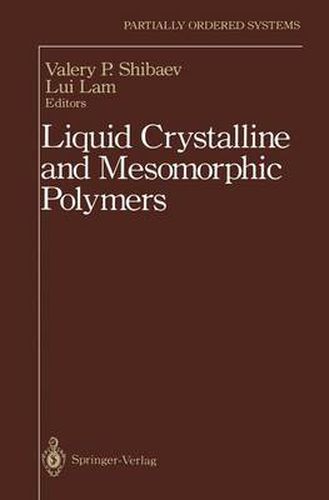Readings Newsletter
Become a Readings Member to make your shopping experience even easier.
Sign in or sign up for free!
You’re not far away from qualifying for FREE standard shipping within Australia
You’ve qualified for FREE standard shipping within Australia
The cart is loading…






This title is printed to order. This book may have been self-published. If so, we cannot guarantee the quality of the content. In the main most books will have gone through the editing process however some may not. We therefore suggest that you be aware of this before ordering this book. If in doubt check either the author or publisher’s details as we are unable to accept any returns unless they are faulty. Please contact us if you have any questions.
Among the various new directions in modern polymer science, the design and investigation of liquid crystal (LC) polymers have been the ones growing most actively and fruitfully. In spite of that, the possible formation of an anisotropic LC phase was only demonstrated theoretically for the first time in the 1950s by Onsager [1] and Flory [2], and then experimentally verified in the studies with polypeptides solutions. In essence, the studies of these LC lyotropic systems did not deviate from the theme of purely academic interest. It was at the beginning of the 1970s that the experimental explosion occurred, when aromatic polyamides were synthesized and their ability to form LC solutions in certain very aggressive solvents was discovered. The search for practical applications of such LC systems was crowned with the successful creation of the new generation of ultrastrong high-modulus ther mostable fibers, such as the Kevlar, due to the high degree of order of the macromolecules in the anisotropic LC state. In fact, these investigations coincided with the swift emergence on the practical scene of thermotropic low-molar-mass liquid crystals, with the use of these materials in microelectronics and electro optics (figures and let ters indicators, displays in personal computers, and flat TV, etc.). Polymer scientists also began to develop methods of synthesizing thermotropic LC polymers by incorporating mesogenic fragments in the main (main-chain LC polymers) or side branchings of the macromolecules (side-chain or comb shaped polymers).
$9.00 standard shipping within Australia
FREE standard shipping within Australia for orders over $100.00
Express & International shipping calculated at checkout
This title is printed to order. This book may have been self-published. If so, we cannot guarantee the quality of the content. In the main most books will have gone through the editing process however some may not. We therefore suggest that you be aware of this before ordering this book. If in doubt check either the author or publisher’s details as we are unable to accept any returns unless they are faulty. Please contact us if you have any questions.
Among the various new directions in modern polymer science, the design and investigation of liquid crystal (LC) polymers have been the ones growing most actively and fruitfully. In spite of that, the possible formation of an anisotropic LC phase was only demonstrated theoretically for the first time in the 1950s by Onsager [1] and Flory [2], and then experimentally verified in the studies with polypeptides solutions. In essence, the studies of these LC lyotropic systems did not deviate from the theme of purely academic interest. It was at the beginning of the 1970s that the experimental explosion occurred, when aromatic polyamides were synthesized and their ability to form LC solutions in certain very aggressive solvents was discovered. The search for practical applications of such LC systems was crowned with the successful creation of the new generation of ultrastrong high-modulus ther mostable fibers, such as the Kevlar, due to the high degree of order of the macromolecules in the anisotropic LC state. In fact, these investigations coincided with the swift emergence on the practical scene of thermotropic low-molar-mass liquid crystals, with the use of these materials in microelectronics and electro optics (figures and let ters indicators, displays in personal computers, and flat TV, etc.). Polymer scientists also began to develop methods of synthesizing thermotropic LC polymers by incorporating mesogenic fragments in the main (main-chain LC polymers) or side branchings of the macromolecules (side-chain or comb shaped polymers).